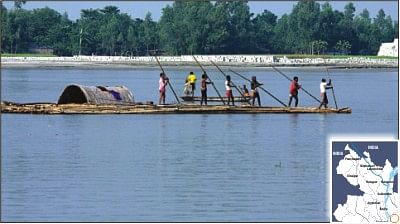Teesta flows in thin

Millions living by the Teesta now have expectation that the secretary-level talks with India will lead to a fair deal on water sharing of this river. Inset, the river enters Bangladesh in Nilphamari on its way to meet the Brahmaputra in Kurigram. Photo: Sk Enamul Haq
The flow of water on the Teesta has weakened significantly in last 24 years for Gajoldoba barrage and some dams built by India in the river's upper basin.
In February and March, it comes down to less than 1,000 cubic feet per second, from 5,000 cubic feet per second in December and January.
At times, it shrinks even further, say sources at the Water Development Board's hydrology department.
For instance, they add, the amount of water dropped to 370 cusec (cubic foot per second) in February 2007.
The water flow in the month used to be 4,000 cusec at the minimum before India built Gajoldoba barrage, some 70 kilometres upstream from Dalia point in Nilphamari in 1985.
This steep drop in the volume of water is because of India holding almost all water during the lean period.
This trend, continuing over the years, means sufferings to thousands of people living downstream and affecting the ecology in the northern districts.
“When the flow plummets to 400 or 370 cubic feet a second, it means little water passes through Gajoldoba barrage. This 400 cusec water is regenerated between Gajoldoba and Teesta barrage in Bangladesh,” said Dr Ainun Nishat, noted hydrologist.
The Teesta, originating from Cholamo Lake at 5,330 metre above sea level in the Indian portion of the Himalayas, enters Bangladesh at Kaliganj village under Satnai union of Nilphamari district.
It courses 45 kilometres through Rangpur, Lalmonirhat and Gaibandha before meeting the Brahmaputra in Kurigram.
Md Shamsuddoha, executive engineer of Water Development Board(northern zone), said India keeps the gates at Gajoldoba barrage closed in winter and redirects the water to its land for irrigation.
“It leaves the river almost dried-up for most of the season,” he observed.
Besides, the dwindling flow of water renders Teesta barrage almost useless during the dry season.
The barrage was built at Domar-Dimla point for Tk 1,500 crore in 1990 to help irrigation in six northern districts.
India started the work of Gajoldoba barrage a few months after Bangladesh began constructing the Teesta barrage in 1983. The Indian barrage opened after two years, while Bangladesh's took seven years to be in operation.
India has also constructed several dams across the Teesta in the last few years. Built under a project to produce 50,000 megawatts of electricity, these dams too contribute to the decreasing water flow in the lower basin, say sources.
The trickling stream of water has led to emergence of a good number of chars on the Teesta.
Navigability of the river has worsened so much that only small boats can now ply the water route there.
Because of the loss of navigability, the river cannot hold the rush of water during the monsoon and bursts its banks, causing floods.
Useless Teesta Barrage
Phase-I of the Teesta Barrage project was completed around 20 years ago.
Under phase-I, the barrage was supposed to irrigate some 50,000 hectares of land in Rangpur and Nilphamari districts during the dry season.
But records show it could irrigate hardly 15,000 hectares of land on average for the last few years.
Originally, the barrage project planned to supply water to around 300,000 hectares of land in Rangpur, Nilphamari, Gaibandha, Dinajpur, Bogra and Joypurhat districts during the dry season.
Phase-II aimed at irrigating the commanding areas under Dinajpur, Bogra, Gaibandha, and Joypurhat districts.
For lack of water in the river, the work under phase-II could not yet be completed.
Sources close to the Teesta Barrage project said at least 40,000 cusec water is needed to irrigate the entire cultivable land in winter. Without this, the project objectives are bound to fail.
Locals and environmentalists of the northern districts, which were once dependent on the Teesta's water for irrigation, have long been demanding an equal apportionment of the water.
Asimuddin, 55, of Betgari union under Gangachara upazila in Rangpur said that some 20 years back, he would cultivate IRRI-Boro rice using floodwater stagnated on land along the Teesta.
“We gave land for building Teesta barrage, hoping to get enough water through canals under the project. But it did not come true as the canals themselves remain parched throughout the dry months,” he added.
Osman Ali, a farmer from the same area, said they have given up hope of ever getting water from Teesta barrage. They now depend on power tube wells to irrigate land for IRRI-Boro.
Tipu Munshi, AL lawmaker from Rangpur-4 constituency, said, “We hope the issue of sharing Teesta water will be settled during the prime minister's upcoming visit to India.”

 For all latest news, follow The Daily Star's Google News channel.
For all latest news, follow The Daily Star's Google News channel. 



Comments